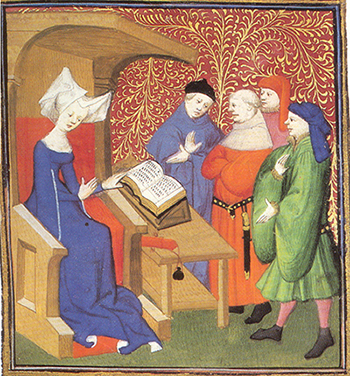| Christine de Pizan | c.1364 - c.1430 | France | Literature |
 Christine de Pizan lecturing to a group of men, 1413.
During the late middle ages in Europe, few women had any control over the direction their lives took. The two principal routes open to them were marriage or admission to a religious community. For most, marriages were arranged for them and took place while they were still in their teens, after which wives became the property of their husbands. The primary focus of both elite and peasant married women’s lives revolved round household responsibilities and only in widowhood did they gain legal independence, but this was not necessarily accompanied by financial security.
Christine de Pizan lecturing to a group of men, 1413.
During the late middle ages in Europe, few women had any control over the direction their lives took. The two principal routes open to them were marriage or admission to a religious community. For most, marriages were arranged for them and took place while they were still in their teens, after which wives became the property of their husbands. The primary focus of both elite and peasant married women’s lives revolved round household responsibilities and only in widowhood did they gain legal independence, but this was not necessarily accompanied by financial security.
Christine de Pizan was married at the age of fifteen and widowed in her mid-twenties. Her father’s financial circumstances had been reduced prior to his own death and she therefore found herself responsible for the support of her mother and a niece in addition to her own three children. Having received an excellent education, she took to writing verses to earn a living and these were well received. This success helped her become one of the first professional female writers in Europe. Her patrons included Louis I, Duke d’Orléans; the Duke de Berry; Philip II the Bold of Burgundy; Queen Isabella of Bavaria and, in England, the 4th Earl of Salisbury. In 1404 she was commissioned by the Duke of Burgundy to write a biography of his deceased brother, King Charles V.
In her most celebrated work, The Book of the City of Ladies, de Pizan tackled the subject of the cause of women. She celebrated women’s accomplishments and pointed to their equal abilities to men’s. She thus revised history by giving women a place in it and showed the elite women of her time how they could successfully navigate their way in a man's world.
 This article is part of the world-changing women collection. All the articles in this collection are specially produced for the How women changed the world interactive tour created to reveal the untold stories the history books left out.
This article is part of the world-changing women collection. All the articles in this collection are specially produced for the How women changed the world interactive tour created to reveal the untold stories the history books left out.
You can also view these articles without the interactive feature here.

Rate and Review
Rate this article
Review this article
Log into OpenLearn to leave reviews and join in the conversation.
Article reviews